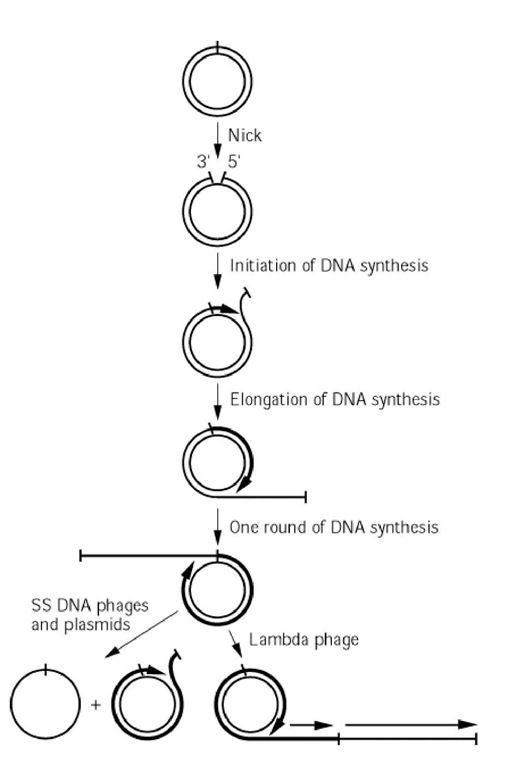Rolling circle mechanism is an alternative method used by bacteriophages and viruses for the transfer of plasmid DNA.
One strand of DNA is nicked to provide the 3' OH group. DNA synthesis begins at the 3' end of the broken strand , the other strand is used as a template . SSB and helicase create a replication fork and nicked strand (5' end of the broken strand is displaced). Replication is initiated by a break in one of the nucleotide strands.
Cleavage releases a single -stranded linear DNA and a double stranded circular DNA.
The linear DNA may circularize and serve as a template for synthesis of a complementary strand . dNTPs are added to the 3'OH group to create the leading strand .
Rep proteins are encoded by RC plasmids that contains specific domains which are involved in origin binding and nicking activities.
The products of rolling -circle replication are multiple circular DNA molecules .

Image source-http://what-when-how.com/molecular-biology/rolling-circle-dna-replication-molecular-biology/
Thank you for visiting my blog.Please feel free to share your comment on this article ,Please subscribe and share the articles to get more such articles.
One strand of DNA is nicked to provide the 3' OH group. DNA synthesis begins at the 3' end of the broken strand , the other strand is used as a template . SSB and helicase create a replication fork and nicked strand (5' end of the broken strand is displaced). Replication is initiated by a break in one of the nucleotide strands.
Cleavage releases a single -stranded linear DNA and a double stranded circular DNA.
The linear DNA may circularize and serve as a template for synthesis of a complementary strand . dNTPs are added to the 3'OH group to create the leading strand .
Rep proteins are encoded by RC plasmids that contains specific domains which are involved in origin binding and nicking activities.
The products of rolling -circle replication are multiple circular DNA molecules .

Image source-http://what-when-how.com/molecular-biology/rolling-circle-dna-replication-molecular-biology/
Thank you for visiting my blog.Please feel free to share your comment on this article ,Please subscribe and share the articles to get more such articles.

No comments:
Post a Comment